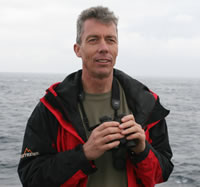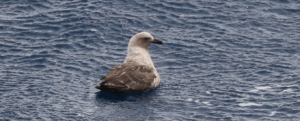 By Peter Ryan, onboard scientist, expert in general ornithology, seabird-fishery interactions, evolutionary ecology, marine debris, solid waste management, biology of oceanic islands.
By Peter Ryan, onboard scientist, expert in general ornithology, seabird-fishery interactions, evolutionary ecology, marine debris, solid waste management, biology of oceanic islands.
Leg 1, Day 14
Rough weather today prevented access to the bow, so we were forced to observe from the bridge. This seemed overly cautious as the bow was dry until 6h30, when the decision was made to tack back south to deploy a pair of floats. The ship turned without warning, rolling heavily and covering the bow with heavy spray. The new course resulted in slow going into 6-8 m swells, and observations were suspended before breakfast. Transects were resumed once we turned for Kerguelen again, but were curtailed after 16h00 when the ship slowed to commence dredging on a seamount west of Kerguelen. Birds were relatively scarce all day, with only 14 species observed. The only real highlight was the trip’s first South Polar Skua, a species that replaces the Brown Skua on continental Antarctica. They are long-distance migrants that mostly winter in the northern hemisphere, but should be farther south by now. It has the distinction of being the only vertebrate other than humans to have reached the South Pole.
| Black-bellied Storm Petrel | 19 | Black-bellied Storm | 15 |
| Crested penguin spp. | 9 | White-chinned Petrel | 6 |
| Diving Petrel spp. | 6 | Wandering Albatross | 5 |
| Black-browed Albatross | 3 | Northern Giant Petrel | 2 |
| Kerguelen Petrel | 2 | Slender-billed Prion | 2 |
| Northern Giant Petrel | 4 | Light-mantled Albatross | 3 |
| Kerguelen Petrel | 3 | Brown Skua | 2 |
| Grey-headed Albatross | 1 | Light-mantled Albatross | 1 |
| Soft-plumaged Petrel | 1 | South Polar Skua | 1 |
No cetaceans or anthropogenic litter were observed. As yesterday, Bull Kelps Durvillaea antarctica were encountered regularly, with most carrying growths of goose barnacles Lepas spp. Some plants were so heavily encrusted that they had started to sink.
